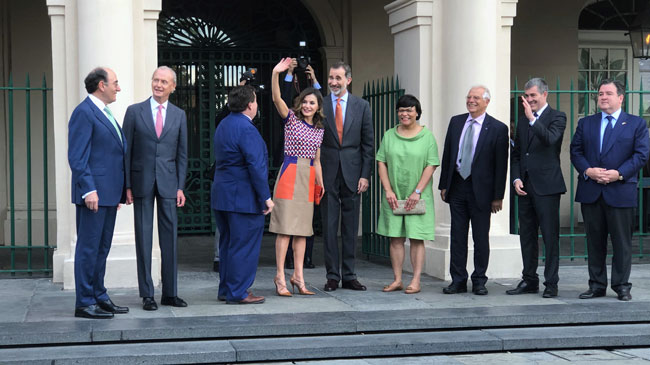
By Prinsey Walker
Paula Dancil, a New Orleans tourist, rushed to a row of barricades outside of the St. Louis Cathedral, to get a glimpse of who spectators awaited. As men and women dressed in business attire exited the Cabildo, bystanders screamed, “Hail King Felipe of Spain.” Following the herd of people around her, she held her camera high in the air, to take a picture for Facebook. Then Dancil posed a question to herself, after capturing the moment. Why is the King of Spain in New Orleans?
New Orleans locals anticipate the appearance of one royal every Fat Tuesday: The King of Carnival. However, as New Orleans rang in the tricentennial year, real life monarchs King Felipe IV and Queen Letizia of Spain, returned to the Crescent City, as part of a three-city visit to the U.S.
The Spanish royals made their first stop in New Orleans, arriving on Thursday, June 14, 2018. They were officially welcomed at Gallier Hall on Friday June 15, 2018 by Mayor LaToya Cantrell and Governor John Bel Edwards. Later in the afternoon on June 15th, the royal couple and Cantrell toured the Cabildo and St. Louis Cathedral in Jackson Square. Upon their arrival, they were welcomed in traditional New Orleans fashion, the smell of fresh beignets and jazz music.
Jennifer Jones, a creole New Orleans tour guide, anticipated the King and Queen’s arrival because she said Spanish culture contributed to the image of New Orleans. “There is Spanish in my blood,” she said. “What you think is the French Quarter is really the Spanish Quarter.”
New Orleans was one of two American cities, developed under Spanish-Colonial Rule. During the City’s era as a Spanish Colony, the Cabildo functioned as the Colonial City Hall.
Before her encounter with the King and Queen in the French Quarter, Dancil said she never knew of New Orleans’ Spanish roots. However, Kimberly Broussard, a New Orleans local said traces of Spanish influence remained in architecture. “Even though the Spanish was the last to occupy the City, we are still more French than Spanish. You can see a lot of the influence in the architecture,” Broussard explained.
Now, the Cabildo serves as museum containing artifacts sharing the History of New Orleans. Exhibits tell stories of the earliest European settlers, to the more recent events, including Hurricane Katrina.
Mary Dugas, a member of the Friends of the Cabildo, a non-profit comprised of volunteers, works as a tour guide for the museum. For the Royal Spanish visit, she dressed in a red evening gown, in the style of a lady in 1770.
“The King stopped to talk to me. They both said I was beautiful,” she said. Dugas felt welcoming the royal tourists was a special moment for her because never before in history, has the King of Spain set foot on New Orleans soil. She credited Spain’s influence on providing more independence for women during their time in New Orleans, historically. “Women had so much freedom here and could own property and have their own businesses,” Dugas explained. “That was because of Spanish Law.”
New Orleans resident, Betty Chaison, who witnessed the gathering, also felt that the meeting of the royals of Spain and Mayor Cantrell was a reflection of the City’s narrative.
“Being it’s the tricentennial celebration, it takes us back to Louisiana History. But now it’s like you get to be a little piece of it. Like full circle to modern time,” she said. Chaison believed Cantrell also cherished this historical occasion.
“Mayor Cantrell is the First Female Mayor in New Orleans,” she said, “I am glad that this is one thing she will have to remember as mayor during her tenure of the City.”
The King and Queen wrapped their visit up in New Orleans being treated to cultural performances at the New Orleans Museum of Art on Saturday, June 16th. They then departed to spend time in San Antonio, another U.S. City also celebrating their tricentennial. After, the Royals will complete their U.S. tour at the White House to meet with President Donald Trump, on June 19th.
Chaison said she felt this meeting strikes an international connection between the United States and Spain. “There’s a lot of angst going on with diplomacy of this country and other countries. As far as them meeting our president right now, it builds a relationship,” Chaison said.
As King Felipe IV ended his French Quarter trip, he told spectators to remember Spanish influence on New Orleans. “It might be said that Spain’s History here in Louisiana is not sufficiently well-known, despite the amount of painstaking research by historians and academics,” he said. “Therefore, we must work to make this Spanish Heritage and no less importantly, the enduring Spanish Legacy here much more widely known.”
Recommended For You.



Be the first to comment